Exhibitions and Events
Regular Exhibitions
01: FA Silver Cup

The FA Silver Cup is made of pure silver and presented in March, 1919 by the Football Association (FA) in England as the sign of the friendship between two countries and their hope to promote football. Although back then Japan did not have a national governing body for football, the receipt of this Cup helped the establishment of Dai-Nippon Shukyu Kyokai (current Japan Football Association / JFA) in 1921. This Cup also started being presented to winners of the Association Football National Championship (current Emperor’s Cup All-Japan Soccer Championship Tournament) that started in this year. Since then the Cup had been favoured as the symbol of the national championship.
During the Second World War, however, it was taken away by the national government as part of their wartime measure to collect metal. When the JFA had their 90th anniversary year in 2011, then president Ogura Junji suggested his idea to the FA to reproduce the Cup, which was welcomed by the English counterpart. The Cup was remade and again presented to the JFA on 23 August that year.
02: J. League Cup (Championship Silver Plate) Replica

The J. League championship Silver Plate has 55cm in diameter and 6kg in weight, and is awarded to the league’s Division 1 champion team. The prize winner is entitled to store the plate for themselves for one year. The Football Museum exhibits its replica and visitors are welcomed to touch and take a photo of it.
The plate has laurel leaves, symbol of victory, around the edge while in small engraved circles various images are depicted based on themes such as “sportsmanship”, “winning”, “tackling”, “passing” and “free kick”. So far there have been nine different clubs who held this plate in their hands. Kashima Antlers won seven times, the most in the league, including the three consecutive years since 2007, and Yokohama F. Marinos and Jubilo Iwata follow with three.
03: Player huddle at 2002 FIFA World Cup Japan-Korea
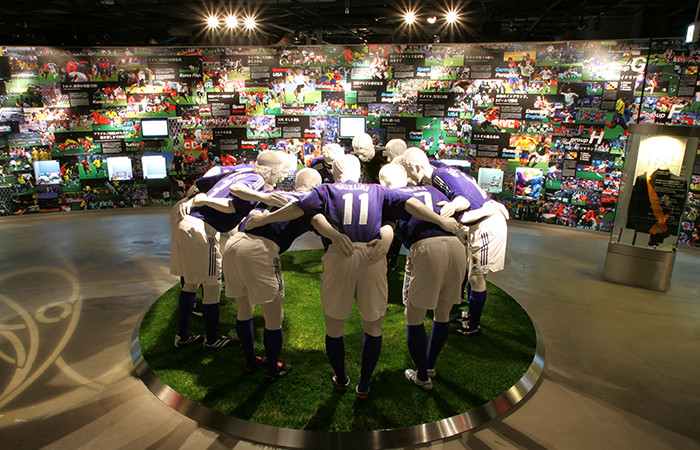
The World Cup held in June, 2002 co-hosted by Japan and Korea was the first World Cup organized by the joint effort of the multiple countries for the Fédération Internationale de Football Association (FIFA) and the first World Cup ever held in Asia.
Not only from all over Japan, but also from many other countries, fans gathered at the stadiums, witnessed exciting matches by all the national representing teams, and jubilated for the plays of the best football players in the world. Also the event was very successful and praised by international visitors as “World Cup of Smiles”, which left tremendous legacy to Japanese football. Japan Football Museum was established in the memory of this World Cup. On the basement two “Pitch” floor, we reproduced the players forming a circle after sealing the first ever World Cup victory for Japan against Russia on 9 June 2002. Life-size player figures are sporting the kits that were actually worn by the real players. The circle is missing one person to complete. Visitors are welcomed to join Nakata Hidetoshi, Miyamoto Tsuneyasu and others in the huddle and feel the World Cup victory.
04: Face mask worn by Miyamoto Tsuneyasu at 2002 FIFA World Cup Japan-Korea
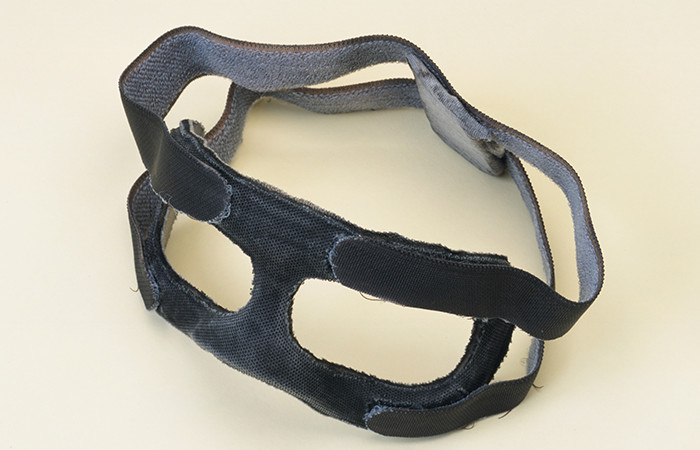
Japan’s captain Miyamoto Tsuneyasu broke his nose in a practice match only days before the 2002 FIFA World Cup Japan-Korea, and the protective face mask was immediately prepared for him. Miyamoto came off the bench in the first match of the group stage against Belgium, but started for the rest of the three matches from the second against Russia to the round 16 against Turkey. As the team captain and the leader of their defence, he helped the team to flourish by his vocal leadership. International media called the masked defender “Batman” and reported his performance to the rest of the world.
There is a side note to this mask. When it was made, the colour was all beige. However, then goalkeeper coach Kawamata Noriyuki advised Miyamoto saying “Black makes you look tougher”. Then Miyamoto followed the coach and coloured it by himself with a black marker.
05: Fair Play Corner
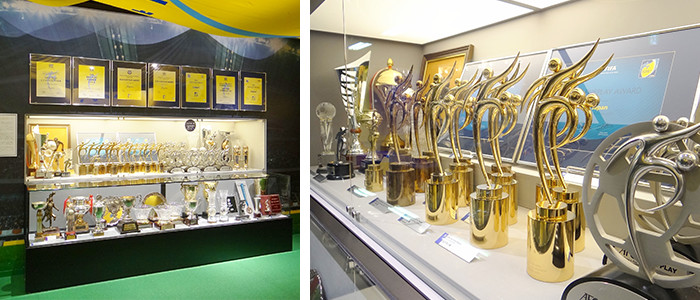
Since the reception of the award at the Mexico Olympics in 1968, Japan national teams of each age and gender category have won numerous Fair Play Awards at tournaments held by the FIFA and the Asia Football Confederation (AFC). The JFA itself has also won the AFC Fair Play Association of the Year Award in four consecutive years since 2007.
All the Fair Play Awards showcased at Japan Football Museum are the proof of all our national teams have been fair and earnest at all times. The FIFA puts great emphasis on “Fair Play Spirit” which can be translated as following rules and respecting opponents as it has even established the Fair Play Day. Receiving such awards so many times is what Japanese football can be proud of to the rest of the world. Development of football can never be materialised without existence of Fair Play Spirit.
The JFA will keep its position as the world leader of Fair Play Awards collection.
06: FIFA Fair Play Award trophy from 2011 FIFA Ballon d`Or
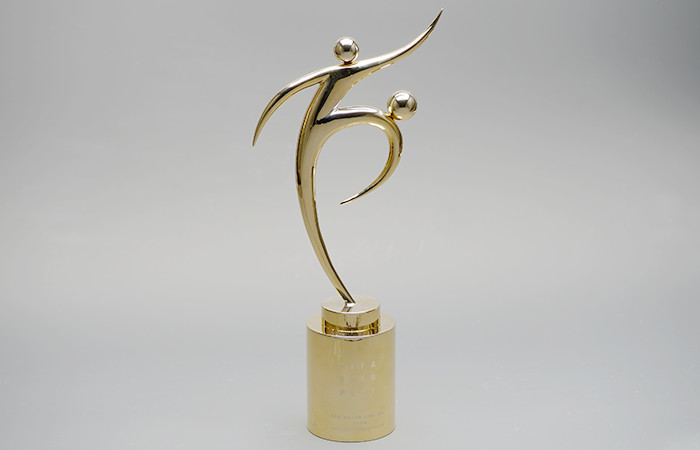
On 9 January 2012, at the 2011 FIFA Ballon d’Or reception, the JFA won was honoured with the FIFA Fair Play Award.
The FIFA Ballon d’Or reception is the awards ceremony where the FIFA recognise players, coaches and associations that have made outstanding accomplishments in that year, and receiving a prestigious award there is one of the highest honours for all people in football.
At the 2011 FIFA Ballon d’Or, Japan received three awards. Sawa Homare was awarded with the FIFA Women’s Player of the Year after she won the FIFA Women’s World Cup Germany 2011 MVP and the scoring title, while her boss on the team, head coach Sasaki Norio received the Coach of the Year award. It was the first time in history that a player and a coach from Asia won those accolades respectively. The JFA was also recognised with the FIFA Fair Play Award for their great contribution to the reconstruction effort after the Great East Japan Earthquake.
07: “HOW TO PLAY ASSOCIATION FOOTBALL” A book published in 1923
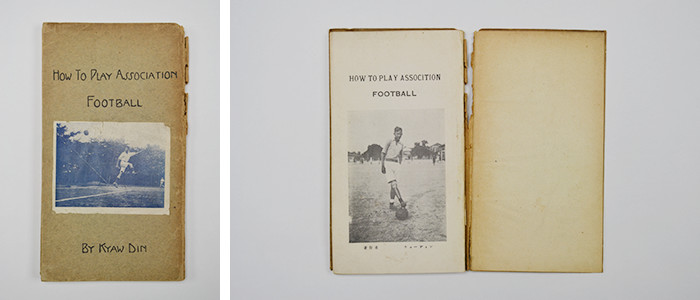
This football coaching book published in 1923 was a Japanese translation of the work by Mr. Kyaw Din. Fundamental skills and tactics are logically introduced with many photos and diagrams, and this book tremendously helped the development of Japanese football’s early stage in the Taisho and early Showa periods.
Mr. Din, an international student from Burma (current Myanmar) is considered the first international football coach in Japanese football and led his Waseda Koto Gakuin school to two national championships at the National High School Association Football Tournament started in 1923. Suzuki Shigeyoshi, who pulled off so-called “Miracle of Berlin” as the national team head coach at the Berlin Olympics was one of Din’s students.
08: National team kit at the 1936 Berlin Olympic
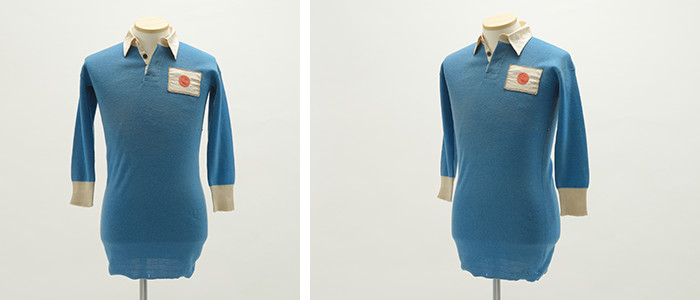
At the Berlin Olympics in 1936, Japan played on an Olympic pitch for the first time. The team mostly consisted of college students ended up in surprising the rest of the world. After being down two goals in the first round against title-favourite Sweden, Kawamoto Taizo (Waseda Univ.), Ukon Tokutaro (Keio Univ.) and Matsunaga Akira (Tokyo Bunri Univ.) scored one goal each for a come-back win. The win was rated as “beautiful and fair upset” by football experts and fans in the world and the story has been passed down from generation to generation as “Miracle of Berlin”
The other episode of this match is that Dr. Yukawa Hideki, Nobel Physics Prize winner in 1949, was given a football by a Swedish reporter who remembered “Miracle of Berlin”.
Japan Football Museum exhibits the shirt worn by forward Kawamoto Taizo who scored Japanese football’s first goal in Olympic matches, which also is the oldest national team shirt of all currently kept in the museum.
See past Japan shirts.
09: TENUGUI from 1936 Berlin Olympics
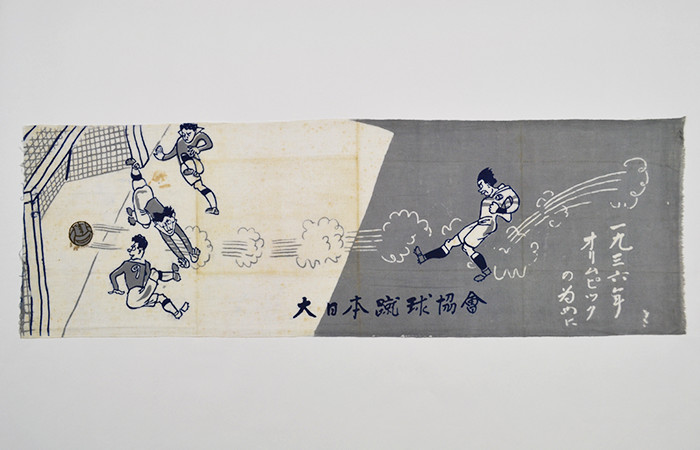
Dai-Nippon Shukyu Kyokai (current Japan Football Association / JFA) sold “TENUGUI” (meaning Japanese style towel) to fund for the team trip to the Berlin Olympics in 1936. The price of the first official gear sold by the Association was JPY0.2 per piece, which can be compared to the average price of rice, JPY2.48 per 10kg, at that time. Other than selling TENUGUIs, the JFA widely called for donations from people in football as well.
The Japan National Team left home on 20 June and arrived in Berlin 14 days later by riding likes of the Trans-Siberian Train. After playing practice matches against local clubs, they were at the match against great Sweden on 4 August, which turned into “Miracle of Berlin”, Japan’s first win in the Olympics.
10: Poster for Japan against Korea match, qualifier for 1954 World Cup Switzerland
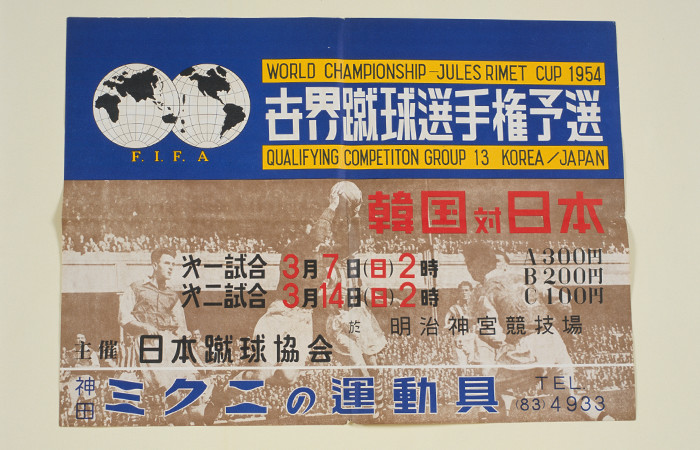
Nippon Shukyu Kyokai (current Japan Football Association / JFA) re-joined the FIFA in 1950, and Japan National Team played in the 1954 FIFA World Cup Switzerland qualifiers for the first time in its history.
The tournament in Switzerland had only 16 teams competing, only one from Asia. The Asian qualifiers came down to two countries, Japan and Korea Republic. Japan fell short for the World Cup spot by finishing with one loss and one draw. Since then, the two countries have been good rivals in many occasions for the World Cups and the Olympics.
It was 44 years later when Japan made the first appearance in the FIFA World Cup. 7 March 1954 was surely the first day of Japan’s long journey to the World Cup and fierce rivalry against Korea.
11: 1964 Letter from Mr. Cramer
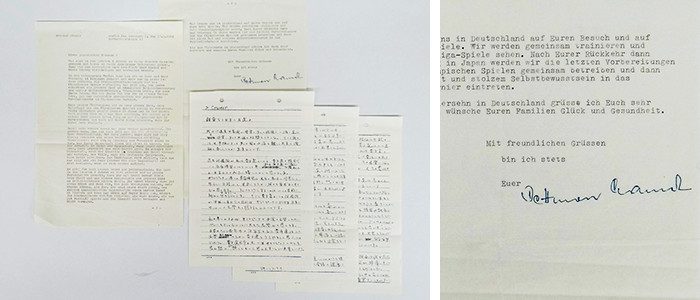
In July 1964, having the Tokyo Olympics around the corner, Japan National Team left for a two-month long training trip in Europe including Soviet Union (current Russia), Rumania, and West Germany. Just before the departure, a letter came in from Mr. Dettmar Cramer, who, as a coach of the Japan National Team, contributed greatly to the development of the team.
In his letter he wrote on honour and responsibility that accompany with being a national team player, attitude to have for the Olympics and demanding but supportive message to the players.
Bettered in the Europe trip, the team survived through to the quarter finals by defeating mighty Argentina in the Tokyo Olympics in October. After the tournament, the German coach left one more message before leaving the team. “The whistle to end a match is also to kick off another.”
12: National team practice gear used by Kawabuchi Saburo at Tokyo Olympics in 1964
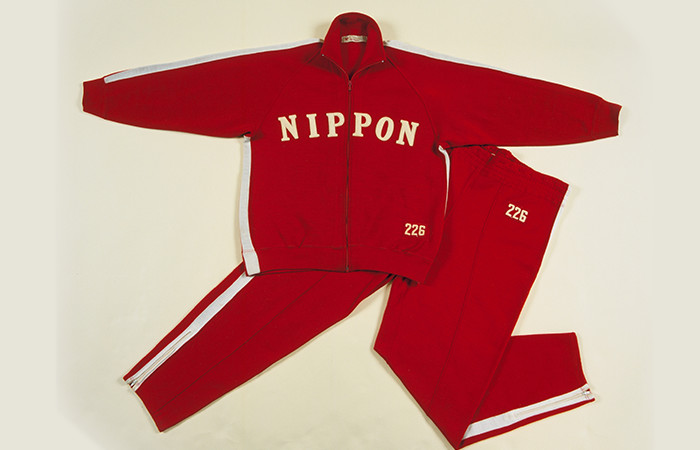
After the qualifier exit for the Rome Olympics in 1959, Nippon Shukyu Kyokai (current Japan Football Association / JFA) started numerous projects to improve the national team with their sight on the Tokyo Olympics to come in 1964.
In August, 1960 the team took on a Europa trip which lasted over 50 days and also decided upon bringing an international coach to the team. In November that year, Mr. Dettmar Cramer, later known as “Father of Japanese Football”, stepped on Japan’s land for his first time from then West Germany Football Association. His attention to fundamental skills and accuracy of plays remarkably improved the Japan National Team.
On 14 October, 1964, in the opening match of the Tokyo Olympics against mighty Argentina, Japan came back from behind for an upset. Then they kept marching out of the group stage to the quarter finals. Japan Football Museum exhibits the training gear of Kawabuchi Saburo, who scored the second goal of the match against Argentina. See past Japan shirts.
See past Japan shirts.
13: Bronze medal won at 1968 Mexico Olympics
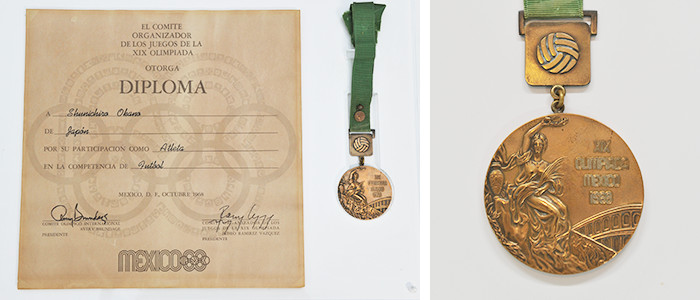
One of the most historic accomplishments in the Japanese football history is the bronze medal won at the Mexico Olympics in 1968.
Japan’s improvement, thanks largely to long years of tutorage by Mr. Dettmar Cramer, led the team to the Mexico Olympics by winning through the qualifiers in Asia. With eyes for matches held at the altitude of over 2,000m, the team travelled to Mexico in March for a training camp there and went through thorough preparation for the upcoming matches. After getting out of the group stage, they defeated France in the quarter final. Although lost to Hungary in the semi-final, Kamamoto Kunishige’s two goals gave the team another victory in the third-place match against home country Mexico. It was the first medal won by an Asian country in Olympics football.
Japan National Team also was awarded with the Fair Play Award by the FIFA, the new award established in that year, and a year later with another Fair Play Award from UNESCO.
14: Japan national team shirt used by Miyamoto Masakatsu at 1968 Mexico Olympics

Led by then head coach Naganuma Ken, Japan National Team travelled to Mexico for the fourth Olympics appearance by the team. Since this tournament, strategic player substitution was allowed up to two players, and head coach Naganuma and then coach Okano Shunichiro aggressively took advantage of this new policy. In the second match against Brazil, Watanabe Masashi was sent to the pitch during the match and scored an equalising goal to give Japan valuable one point. Yaegashi Shigeo had to stop playing due to an injury he suffered in the first match, but he kept supporting the team off the pitch. Meanwhile then coach Hiraki Ryuzo did his best in scouting opponents. The entire team, including players and staffers, came together for one common goal, which enabled them to win the third place. Japan Football Museum exhibits Miyamoto Masakatsu’s kit.
See past Japan shirts.
15: J. League’s opening declaration in 1993
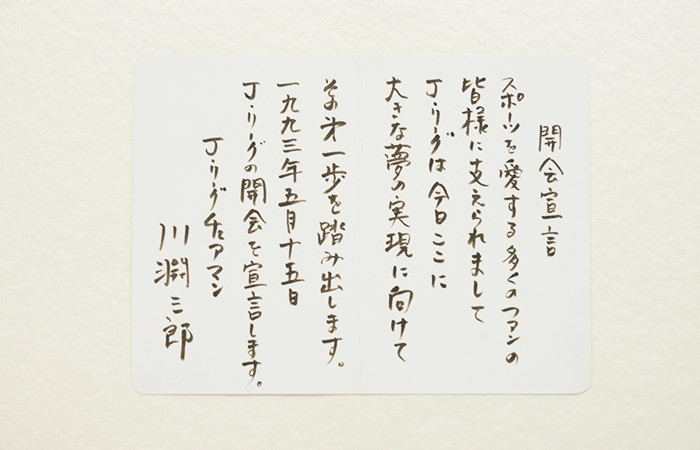
On 15 May 1993, in front of 59,626 who filled the National Stadium, then the League chairman Kawabuchi Saburo (current JFA Supreme Advisor) loudly and proudly declared the opening of J. League, the first professional football league in Japan.
The league was established with three visions: “to raise the level of Japanese football and promote the diffusion of the game”, “to foster the development of Japan's sporting culture and to assist in the healthy mental and physical growth of Japanese people”, and “to contribute to international friendship and exchange”. The birth of the professional league drastically changed the landscape surrounding Japanese football and as a result, the industry dramatically improved. That day, the history of Japanese football certainly started a new chapter.
16: Official ball used for J. League’s opening match in 1993
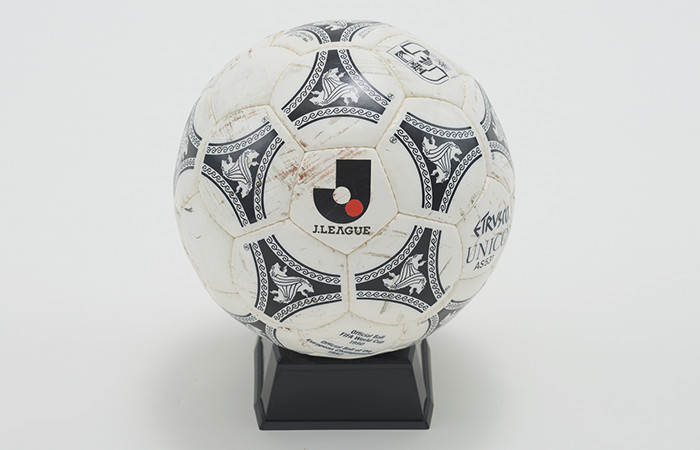
It was an Etrusco Unico brand football made by adidas that was used for the J. League opening match, Verdy Kawasaki against Yokohama Marinos, at the National Stadium on 15 May 1993. Since then 14 different balls have been used as the league’s official match ball to produce countless dramas and excitements. The first goal of the league history was scored in the 19th minute of the match by Kawasaki Verdy’s Meijer with his right-footed 25-meter-range shot from just outside of the penalty box.
Gamba Osaka’s Maeda Masafumi scored the memorial 10,000th goal for the league on 8 May, 2005 against Nagoya Grampus. It was also the first goal for his J.League career.
By the end of the 2013 season, approximately 17,000 goals were scored in the league history.
17: Equipment used by Kamikawa Toru at 2006 FIFA World Cup Germany
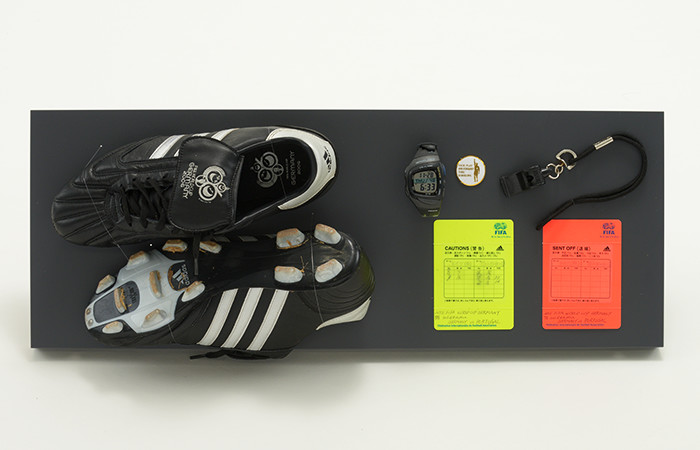
Following the 2002 FIFA World Cup, Kamikawa Toru was assigned for another refereeing duty at the 2006 FIFA World Cup Germany along with second referee Hiroshima Yoshikazu. With their well-rated group stage performance, the two Japanese country men were appointed for the third place match as well.
The former Nippon Shukyu Kyokai (current Japan Football Association/JFA) began its referee development programme in 1954. Maruyama Yoshiyuki participated in the 1970 FIFA World Cup Mexico as the first-ever Japanese to officiate a World Cup match. Since 1990s, the JFA has worked on the referee improvement through on-the-job experience in J.League matches and international referee-exchange programmes. As the result of these efforts, Japanese referees are now highly acclaimed by other countries for their steady and fair refereeing to control matches.
18: Trophy of 2011 FIFA Women’s World Cup Germany
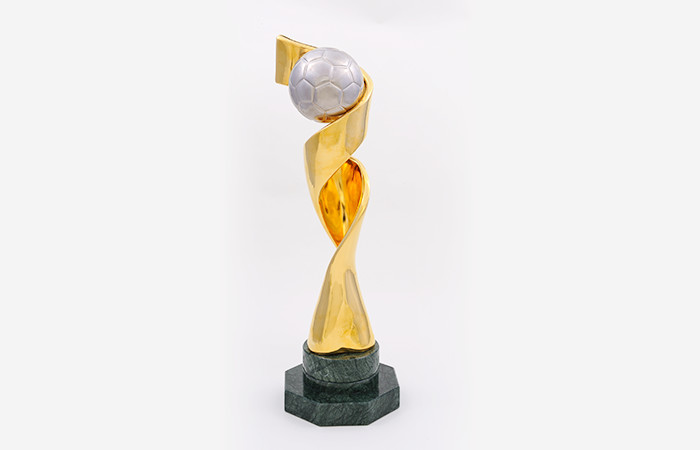
At the 2011 FIFA Women’s World Cup Germany, Nadeshiko Japan (Japan National Women’s Team) clinched the first-ever crown at any FIFA-hosting tournaments in their history. It was Japan’s sixth appearance in the FIFA Women’s World Cups.
After getting through the group stage with two wins and one loss, they eliminated the host country Germany in an extra-time contest in the quarter-final and notched a comeback victory over Sweden in the semi-final. The final was set against the USA, who Japan had never capped a victory against. Nadeshiko allowed a lead twice, yet after two equalisers from Miyama Aya and Sawa Homare, the contest got into the penalty shootouts. The tenacious Japan edged the penalty shootouts 3-1 thanks to outstanding saves by their goalkeeper Kaihori Ayumi.
Japan National Women’s Team was first assembled in June 1981. After 30 years, Nadeshiko Japan, grown big by taking over the traditional fair and tenacious playing style, grabbed the world title.
19: Sawa Homare’s shoes worn at 2011 FIFA Women’s World Cup Germany Final
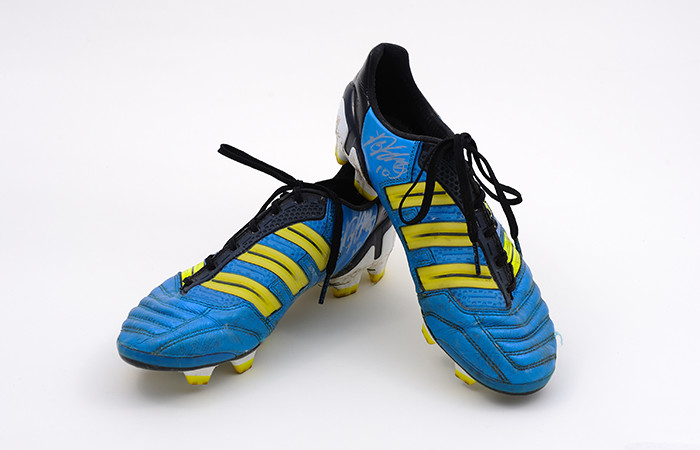
The shoes used by Sawa Homare in the final match of the 2011 FIFA Women’s World Cup Germany are displayed in the Museum.
She has capped 197 matches and scored 82 goals for Nadeshiko Japan (as of 25 May 2014). Sawa, having scored more national-team goals than any other Japanese player, both male and female, grew to the undisputed centrepiece of the team after selected for Japan Women’s National Team for her first time at the age of 15 in 1993.
The midfielder played in five FIFA Women’s World Cups and four Olympics and was awarded with the MVP and the top scorer title in the 2011 FIFA Women’s World Cup Germany, on her way to winning that year’s FIFA Women’s World Player of the Year. She also contributed to the first Olympic silver medal for Japanese football, both male and female, at the London Olympics in 2012.
Sawa has been the backbone of Nadeshiko Japan as she had led with her incessant running, football IQ both in offence and defence and consistent performance backed by her rich experience.
20: People's Honour Award in 2011
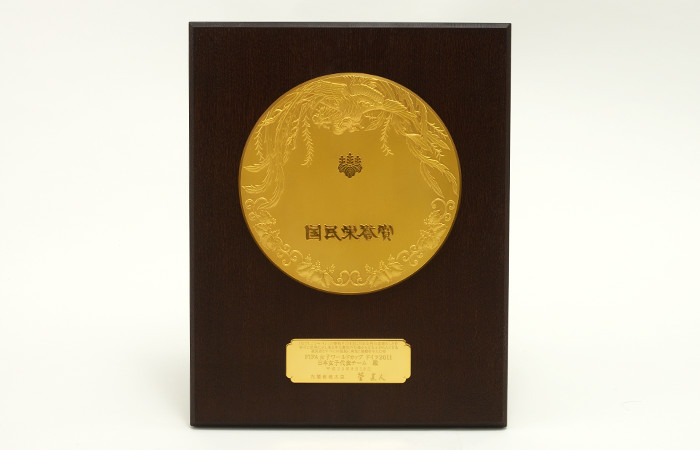
On 18 August 2011, Nadeshiko Japan (Japan National Women’s Team) was presented with the People's Honour Award by former Prime Minister Kan Naoto.
The triumph of Nadeshiko Japan in the same year, who won the FIFA Women’s World Cup Germany for the first time, gave Japanese people courage to face difficulties, especially to those who suffered devastation by the Great East Japan Earthquake. Nadeshiko squad won the great admiration for their tenacious hustle and ever-lasting energy. With the highly regarded feat, Nadeshiko Japan received the People's Honour Award as the 19th awardee of the award’s history and as the first-ever group awardee.
21: Trophy of FIFA U-17 Women’s World Cup Costa Rica
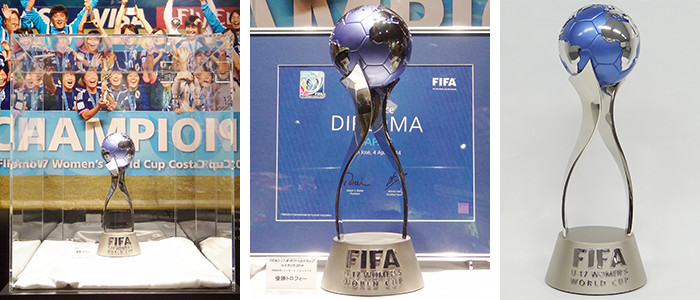
Japan National Women’s U-17 Team, led by Takakura Asako, took on the 2014 FIFA U-17 Women’s World Cup Costa Rica in 2014 with young eyes set for the championship.
After getting off to a good start by winning the opening match against Spain 2-0, the young Nadeshiko added a victory after victory all the way to the final by their collective attacking football with abundant running effort led by captain Sugita Hina and Hasegawa Yui. The final appearance was the second time since they became the runners-up in the Cup in Trinidad and Tobago in 2010.
In the final, Japan faced Spain for the second time in the tournament. Unlike their rather-manageable opening match, they were forced with a close contest but tenaciously converted goal-scoring chances for a 2-0 win. Japan Women’s U-17 National Team exhibited a strong presence with 23 goals scored and just one goal allowed in six matches. The world’s No.1 squad held the championship trophy high.
22: FIFA World Cup Trophy (Replica)
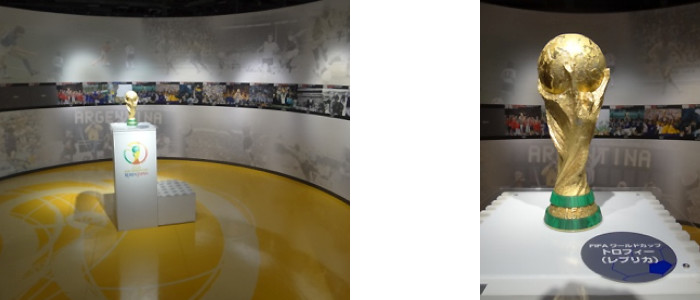
There have been only eight nations who gained the FIFA World Cup Trophy as of 3 July 2014. “Jules Rime Trophy” is the trophy from the first World Cup in 1930 to the ninth in 1970 and was presented to Brazil as the eternal cup holder when they won their third Cup in 1970. The second-generation trophy, renewed in 1973, was used from the 10th tournament in 1974 and called as “FIFA World Cup Trophy.” Before the 18th tournament in 2006, the second trophy was partially redesigned and now became the third generation. Japan Football Museum exhibits a replica of the third-generation trophy, which visitors can feel free to touch.
※2014年7月3日時点
23: Documents used in meeting for last match of 1994 FIFA World Cup USA Asian Qualifiers

Japan National Team got just one step away from the long-awaited FIFA World Cup berth in the last match of 1994 FIFA World Cup USA Asian Qualifiers on 28 October 1993.
Japan Football Museum stores the document used at the meeting before the important match against Iraq. On the upper right of the paper, there is a word “USA 90min (90 minutes before the USA)” and on the left, head coach Hans Ooft’s tactics and stance for the Iraq match including “Small Field”, “Wide Attack” and “Have patience” are written. Japan conceded a goal in the closing minutes for a draw and just missed the ticket for the finals. The valuable document lets visitors feel how Japan fought the match, called “Tragedy of Doha.”
24: Japan National Team shirt used at 1998 FIFA World Cup France (worn by Ihara Masami)
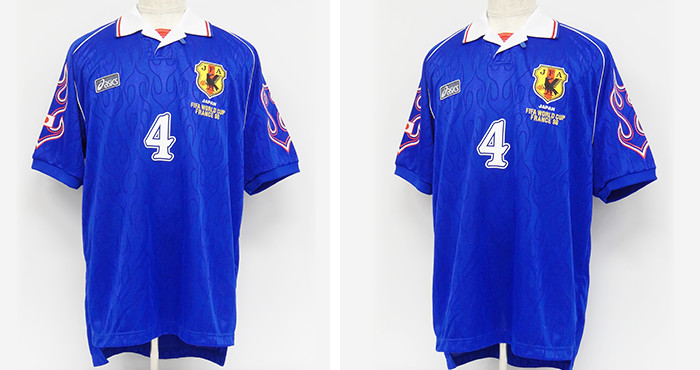
Japan National Team claimed the first-ever World Cup berth after four years from “Tragedy of Doha.” Japan Football Museum exhibits the kit of captain Ihara Masami.
Japan met Argentina and other world’s leading nations for their World Cup debut at the 1998 FIFA World Cup France. They suffered three straight defeats in the group stage but steadily developed from the experience to continue their consecutive World Cup appearances since 2002.
Japan got through the group stage and reached the final 16 in 2002 (Japan-Korea) and in 2010 (South Africa).
See past Japan shirts
25: Japan National Team shirt used at 2010 FIFA World Cup South Africa (worn by Hasebe Makoto)
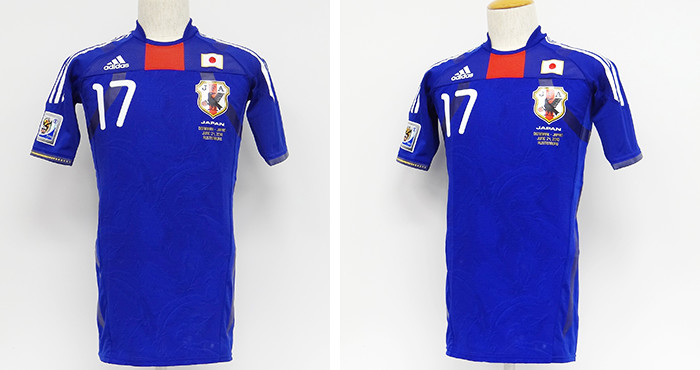
SAMURAI BLUE (Japan National Team) took on the 2010 FIFA World Cup South Africa with eyes for the final four under the slogan “Win It and Surprise the World.” Since Japan had not played in their friendlies leading to the Cup as favourably as they wanted, fans’ anxiety was mounting up. Japan’s boss Okada Takeshi, looking to break a deadlock, assigned Hasebe Makoto for the game captain at the friendly against England on 30 May 2014. Hasebe played the finals with the captain’s armband kept on him as well.
Japan won their opening match 1-0 over Cameroon. They lost the following match against Netherland but defeated Demark 3-1 in the third match to pass through the group stage at the World Cup for the first time except for the one held on their home land. In the round 16 where they played with high expectation of fans at home, the match against Paraguay entered penalty shootouts after extra-time with the score at 0-0. Despite fans’ cheers and wishes, Japan eventually fell short there. Japan’s performance was highly acclaimed by international experts and many players took advantage of the showcase to chase for their individual careers overseas. Japan Football Museum exhibits the kits of Hasebe, the great leader of the team.
See past Japan shirts






